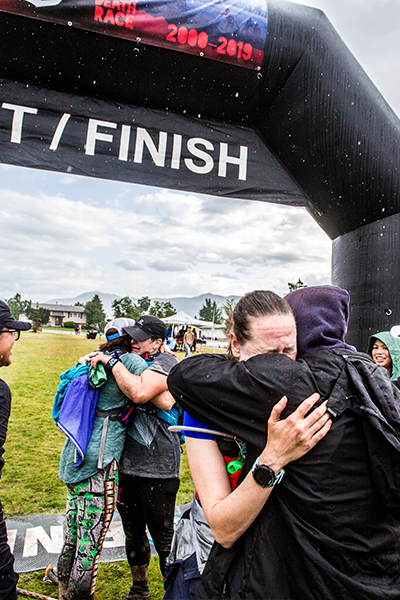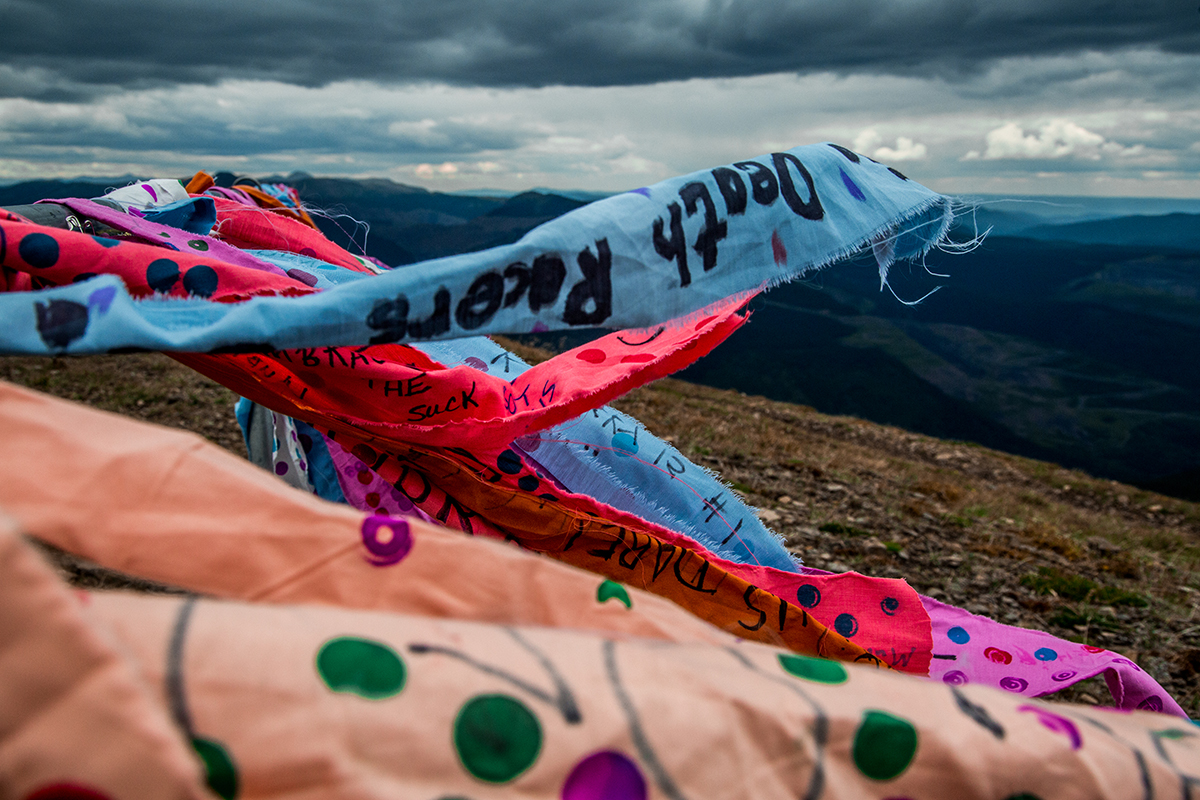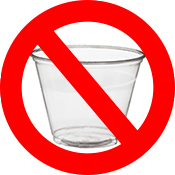


Thanks for signing up for the Canadian Death Race. The race has been challenging runners since 2000, and we are so excited to continue this legacy. The Canadian Death Race combines some of the best trails in the area with viewpoints and scenery that only a few people ever get to enjoy. Both solo and relay runners alike will find this race a daunting challenge.
We hope this package will cover all of the information you need to know and more. It was written with the über-planner in mind, so we hope it covers all of the details. We want to provide an amazing experience from start to finish. We’re racers too and know it can be frustrating if something seems to be missing or vague. Contact us at any time and we will be happy to answer your questions or clarify race details for you.
Thank you again for signing up and we look forward to seeing you at the race.
Brian Gallant
Race Director
Email:

Photo by Raven Eye Photography
The following changes to the course and race format all come from racer requests and our own logistical concerns. Everything is detailed elsewhere in the document but here is an overview.
CP214 has moved to it's previous location. The trail to CP214 was remediated during logging clean-up. So we are going to use the old CP219 location. That location had been closed as the road had fallen into disrepair, but it has improved since 2019, which was the last time we used that site.
The nearest commercial airport (Domestic): Grande Prairie (YQU) + 2 hours drive. International Airports: Edmonton (YEG) + 5 hours drive, Calgary (YCG) + 8 hours drive. These airports offer daily flights to regional destinations on WestJet and Air Canada. Carpooling is encouraged. Check out our Facebook page for Racers coming to train in the weekends leading up to the race.
Grande Cache is located 142km North of Hinton, and 184km South of Grande Prairie on the Bighorn Highway 40. Grande Cache is nestled on top of a 4,200ft plateau and is surrounded by 6000ft to 7000ft mountains on all sides. The scenery is as impressive as the challenge that lies ahead.
From Edmonton: Take Highway 16 west toward Jasper. After Hinton turn North up Highway 40 to Grande Cache. This takes about 5 hours by car.
From Calgary: (The Scenic Route) Highly recommended, especially if this is your first time to the region. From Calgary drive up the Jasper/Banff Ice Fields Parkway, an absolutely breathtaking trip through the Rockies with spectacular glaciers, waterfalls and rocky mountain towns (including Canmore, Banff, Lake Louise, and Jasper). Trip time about 7 hours. For a shorter trip, go via Highway 22 or 2.
Race package pick-up and sign in will be held at Grande Cache Recreation Centre from 12:00pm to 8:00pm on Friday. Solos will also check in drop-bags, if necessary, at this time. If you are unable to attend on Friday night, we do not check in racers on Saturday morning.
The race will start and finish in Central Park, just to the west of the recreation centre.
The post-race awards will be held in the recreation centre. (Pending Covid restrictions)
Celebrate or commiserate with your fellow Death Racers at the post-race brunch and awards. Everyone is welcome, whether or not you finish the race, so please do stay and share your experiences. We will also honour racers for achievements such as First Blood, the Trevor Nickel Spirit Award, and more. Stick around – who knows what you may qualify for.
We strongly recommend that racers carry the following gear. You may elect to carry additional gear, like bear spray, at your discretion.
If you do not wear your timing chip or bib number and carry the Death Race Coin, as per the race rules, you are not considered a competitor in the event.
While the list above is suggested gear, please consider bringing extra kit that will help you in case of foul weather or crushing heat. These items can be stored in your support vehicle for easy access. Also see the Support Crew Information other ideas.
Updated April 30, 2019
New! See our new Gender Category Policy.
Be prepared for the Canadian Death Race. You are the best person to help get yourself through the course and out of any trouble you encounter. During the race, you will be in some very isolated areas and may not have immediate access to facilities, or assistance of any sort. If you are running solo and cannot complete the 118km course in the less than 13 hours, you will be running in the dark. The Canadian Death Race is as mentally demanding as it is physically grueling. We cannot stress enough that you will need to be self-sufficient when you are out there and the help you receive on course is very limited.
Please note that any course descriptions in this document are subject to change due to environmental factors, weather, and wildlife activity. We will do our best to update you if changes arise prior to the race but we will confirm all of the details at the pre-race meeting.
You will be running in remote wilderness, and the chance of injury is very real so prepare to be self-sufficient. We hire top-notch medical staff but they cannot be everywhere at once. If you are injured out on the course, be ready to hunker down for a few hours until a course sweeper or medic comes by. If you are injured but able to move, try and make it to the nearest Transition or Checkpoint. If not, try and send word with another racer or use a cell phone. Race marshals will be sweeping the course one to two hours after all runners have started the leg. Please take the time to read the Emergency Protocol document on our website.
There are definitely bears and cougars in the area. If there is reported activity around the course prior to, or during the race, we may modify the course. We cannot predict random animal activity so stay alert. Take note of the information pamphlets, which will be available at registration, on what to do if you come across a bear or cougar on the trail.
If you drop out of the race, it is essential that you contact the race HQ. If you do not, we will assume you are lost or injured and we will be out looking for you. If we mobilize a search party, you will be charged for any search and rescue fees that are incurred as this takes up valuable resources. Please just take a few minutes to check in. Even if you do drop out, we want you to join us at the awards lunch so you can share your stories and join in the camaraderie.
If you have a medical condition or take medications that may affect your race in any way, you should consult your doctor before competing. We will have medical staff on site to help with first aid, search and rescue, and emergency transport only. They will not assess if you are capable to run. If you do have a condition that our medics need to know about, please fill out the Medical Form on our website. This is confidential and only used by our medics in case of emergency.
118k runners have 24 hours to complete the course. Near Death Marathon runners have 9.5 hours. After that, you will not be able to continue the race. Each leg also has a cut-off time defined in the Race Rules; you must keep up with these times or you will not be able to finish in the allotted time. In addition, you must also start each leg by a specified time or you will not be allowed to continue.
Please see the Race Rules for full details.
The start and finish area is located in Central Park, just west of the Grande Cache recreation centre. Parking is located at the south side of the centre, as well as on the street.
Between each stage of the race is a Transition Area (TA) located next to the start/finish area. At the TA you will be able to access supplies, meet your support crew or relay runner and take a break in relative comfort. The TA will also have some basic facilities such as washrooms, snacks, water, and shelters.
When you finish a leg, you will pass through a chute which will allow you to check in, get your time, and continue on to the next leg. This is also where relay runners will tag off. These chutes are extremely visible and will have large signs stating the end of the leg and where to go for the start of the next leg. Race crew and volunteers will be waiting at the chutes to assist you if required. It is critical that you follow instructions in order to avoid confusion. We know you will be tired and probably delirious, but please be aware of the signs.
All solos are allowed to have a drop bag at each TA and CP423. If you are running the relay, you are still allowed to have drop bags, but please try to have any necessary gear with your teammates.
We will provide labels for your bags at racer check-in with a different colour for each TA. Drop bags will only be accepted at check-in on the Friday before the race. Bags will be placed in a line at the TA so make your gear noticeable. Use a weatherproof bag or bin, as we may not be able to shelter this gear. If you feel you can get by without support or drop bags, this is perfectly acceptable.
You will need to meet the previous runner on your team at the TA which starts your leg. There is a designated chute for racers to enter and leave a TA. Please do not linger at the entrance or exits to the chutes – this holds up everyone else and creates a traffic jam.
Try to be at the TA, ready to meet your runner, 30 minutes before they are expected. We are not able to give ongoing updates as to where runners are on the course so it is up to you to be ready. If you are not at the TA when your runner comes in, you do not get any time credit. There are also cut-off times listed in the Race Rules. If a team cannot keep up with these times, they will be given a forced start or disqualified. In the event of a forced start, relay racers are more than welcome to run but without an official time. If this is the case you still must start by the specified time.
The course is further divided by several Checkpoints (CPs) staffed by race marshals. These locations are typically remote and act as safety points. All CPs are equipped with a radio and some have emergency supplies. Some, not all, also have food and fluids.
The Canadian Death Race course will be well marked with flagging, signs and reflectors. There are a lot of trails out there, so you must pay attention to which leg you are running. Leg numbers are posted on all of our signs to help remove any guesswork. We cannot flag every 100m of the course but we will put markers in critical areas. All trail junctions will have a number of markers to show the right direction. If you don’t see a flag or sign for a while, you may want to retrace your steps to the last junction. Since the course is all counter-clockwise, you will be making mostly right turns at junctions… but watch the signs.
We will talk about course markings at the racer meeting. Remember: It is still up to you to stay alert and watch for markers. We will do our best to make them frequent and visible, but the rest is up to you. We highly recommend reviewing the route on our website and making a visit to the area to run the course ahead of time.

We will have a variety of snacks available at TAs. We cannot accommodate every need so please plan to bring anything you really want via support crews, drop bags, or your relay teammates. Most CPs will also have fluids and snack food. Water stations are marked on the course map. Here is what you can expect:
CPs
Candy, chips, chocolate, cookies, electrolyte, salty snacks, and water
Note that all of our Checkpoints are cupless. You must bring your own container (bladder, bottle, cup).
TAs
All of the CP foods plus fresh fruit, beef jerky, bread with spreads, brownies and packaged squares, cola, gels, pickles, and trail mix
Finish
All of the above plus broth, oatmeal, and noodles from evening until early morning
TA-500
All of the above plus meatballs in tomato sauce, and pierogies in the evening until early morning
DO NOT use aid station water for cooling your body - it is only for drinking. Every time you douse your head, you are taking away drinking water from another runner. Instead, use one of the many rivulets you will pass. We recommend that you be prepared to drink from streams or rivulets if you need water when higher up in the mountains. The water in the area is generally clean, and besides, illnesses like Beaver Fever take about two weeks to manifest symptoms so you should be fine for the duration of the race! Anything after that is your problem...
Also note that all food and supplies are for racers and volunteers only. Relay runners are welcome to eat at aid stations on their leg, but spectators and support crews need to bring their own food; we do not want to run short.
Every year we get a report of a racer seeing a bear or cougar on the course. The reality is that most encounters with these animals rarely lead to aggressive behaviour and attacks are even rarer. Bears especially prefer to avoid contact with humans, and any animal you do see is probably just as anxious to get away as you are.
The best way to prevent an unpleasant encounter is to avoid them all together. Bears and cougars usually avoid humans, and most people don’t even know when they’ve come close to an animal. To ensure a surprise or unpleasant encounter doesn’t occur, try to remain with other runners as much as possible and make lots of noise by talking or singing. Put the iPod away and pay attention to your surroundings. This is the main reason we do not allow headphones on course.
If you do encounter a bear or cougar, pepper spray and bear bangers can be useful IF you know how to use them. Remain calm. Stay together if you are in a group; you will appear larger and more intimidating if you stick together. Identify yourself by speaking in a calm, appeasing tone. Back away slowly, preferably in the direction you came. Walk, don’t run, and keep your eye on the bear so you can see how it will react. In most cases, the animal will flee.
To learn more about bear encounters, check out these BearSmart guidelines, or the Alberta Bear Smart brochure. For cougar information, read the Alberta Cougar safety brochure.
Full Course | Full Near Death Marathon | Leg 1 | Leg 2 | Leg 3 | Leg 4 | Leg 5 | Kids Death Race
Total Distance: 41.1km/25.53mi (Marathon) | 118km/73.32mi (Ultra)
Total Elev. Gain: 1,700m/5,577' (Marathon) | 4,543m/14,905' (Ultra)
Duration: 9.5 (Marathon) – 24h (Ultra)
Cutoff Times*:
†The race starts at 8:00am sharp. Runners who are not at the start line at this time may be disqualified. For safety reasons, all runners are expected to follow the lead vehicle.
*Except for the Finish, all cutoffs indicate the time the racer must start the leg of the race. Note that if poor conditions persist, Race Admin reserves the right to change or add cutoff times as required in order to manage racer and volunteer safety.
Distance: 16.6km
Elevation: +244m / -287m
Description: Approximately 1 km of initial pavement, followed by trail and 8 km of gravel road. It includes a net elevation loss of 500 feet, rolling hills with flat sections, several creek crossings, and one significant downhill. The course will start in downtown Grande Cache at Central Park. It then continues past Grande Cache Lake and Peavine Lake, mainly on quad trails, and includes a section along a ridge with a spectacular view of Peavine Lake and the mountains of Willmore Wilderness Park. After crossing Washy Creek and skirting the north end of the CN rail yard through a deep mud bog, enter the first full aid station and relay exchange zone.
Distance: 27.4km (~25.7 Marathon)
Elevation: +1,624m / -1,526m
Description: Includes about 1 km of pavement. The rest is dirt trail with rocky and swampy sections and approximately 6 km of hard packed dirt road. Net elevation gain is 500 feet, but the total elevation change is well over 6000 feet. This leg of the race is characterized by long sustained climbing with about 3 km of very rough terrain and two creek crossings. The trail from the summit of Flood Mountain to the summit of Grande Mountain is the roughest piece of trail in the Death Race. The power line down the front of Grande Mountain leading back into town is the most dangerous part of the entire course. This is due to the steep, rocky drop-offs and unstable footing while running downhill. The Slugfest is the most technical section and is rated the second hardest leg of the Death Race (although many rate this leg as the hardest of all). The Near Death Marathon course bypasses the Flood Summit Loop but otherwise is the exact same Legs 1 and 2 and finishes at the Start/Finish Line at the end of Leg 2.
Distance: 20.5km
Elevation: +345m / -632m
Description: A bit of pavement to start and the rest is a dirt road with several creek crossings. One creek runs right down the trail as you descend the first part of the Mine Road; making for very slippery, rocky, terrain for 30 meters. This section passes through the lowest point in the race, hitting the very bottom of the Smoky River valley floor, with knee deep water for 25 meters. (If it’s a wet summer, it's worse.) With a net elevation loss of over 600m, this section is the fastest and easiest of the race and one of the most beautiful, offering stunning views of the Smoky River valley.
Distance: 35.2km
Elevation: +1,576m / -1,549m
Description: This is mostly dirt trail and hard packed gravel. While the net elevation gain is almost zero, the total elevation change is well over 1,500m, which comes practically all at once. The ascent of Mount Hamell is broken into two very long climbs, with one small reprieve as you gain the shoulder of the mountain at the mid-point. At the forestry tower on the summit of Mount Hamell, runners check in and then continue toward the spectacular cliff bluffs at Hell's Canyon, where they must retrieve a prayer flag as proof they have made the turnaround point. The descent is strewn with boulders and deep ruts. The downhill is not that technical, but any falls will be on very unforgiving ground. (Read the waiver section about being in remote areas and not being rescued in time to prevent serious injury or death.) This entire leg is fantastically scenic.
Distance: 18.5km
Elevation: +749m / -476m
Description: Includes 1 km pavement, 6 km gravel road, and a river crossing. The rest is dirt trail, grass, and single track. This section runs from the Northwest end of the Hell’s Gate Access Road southward to the Sulphur Gates Road - across from the Hell’s Gate emergency aid station. It crosses the Hell’s Gate road and heads down to the Boat Launch Road. Runners will be ferried across the Smoky River. There is an emergency aid station on the west bank of the river. From the raft crossing, racers will proceed up the east shore of the Smoky River and follow the trail to the Sulphur Rim trail. The course passes the Firemen's Park, heads up Firemen's Park Road and continues to the Finish line in the Grande Cache town square. Please note: For most runners, this leg will be completed in darkness with much of the trail under a heavy canopy of trees, so eye protection is required. Although this section is well marked with reflective markers, flagging tape, and signs, we recommend you bring a halogen headlamp with brand new alkaline batteries. Daylight training on this part of the course is highly recommended. In Greek mythology, Charon is the ferryman of Hades who carries souls of the newly deceased across the river Styx that divides the world of the living from the world of the dead. A coin is used to pay Charon for passage. This coin must be carried at all times by soloists and the runner for each leg and given to the grim reaper at the river for access to the boat. Runners who lose their coin will not be permitted access to the boat resulting in a DNF.
Support people (aka Support Crews) are typically only required for solo runners as most relay runners do one leg and hand off to a teammate at the TA. A good support person can truly be the lifeline for a solo racer. Nothing beats coming into a TA where there is food, fresh gear, and encouraging words waiting. Support people help keep their racer moving. If you intend to support a racer, do not be afraid to ask questions – we want your experience to be as rewarding for you as it is for the competitors.
Support crews may set up a site next to the TA. We ask that you keep your site minimal. Always follow the directions of site crews and volunteers.
If your racer doesn’t look well (delirious, dehydrated, or somehow broken), please contact our staff. The racer will not be disqualified for receiving medical aid.
Please keep your site simple as there is not a lot of room. You cannot light a fire at the TA. Make sure you have enough gear to keep yourself comfortable during the race. You will be in the mountains and it can get pretty cold at night. There can also be blistering heat during the day. Suggested crew gear:
Driving directions to all of our transition areas are available on Google Drive.
©2020-2023 Sinister Sports Inc. All Rights Reserved.







